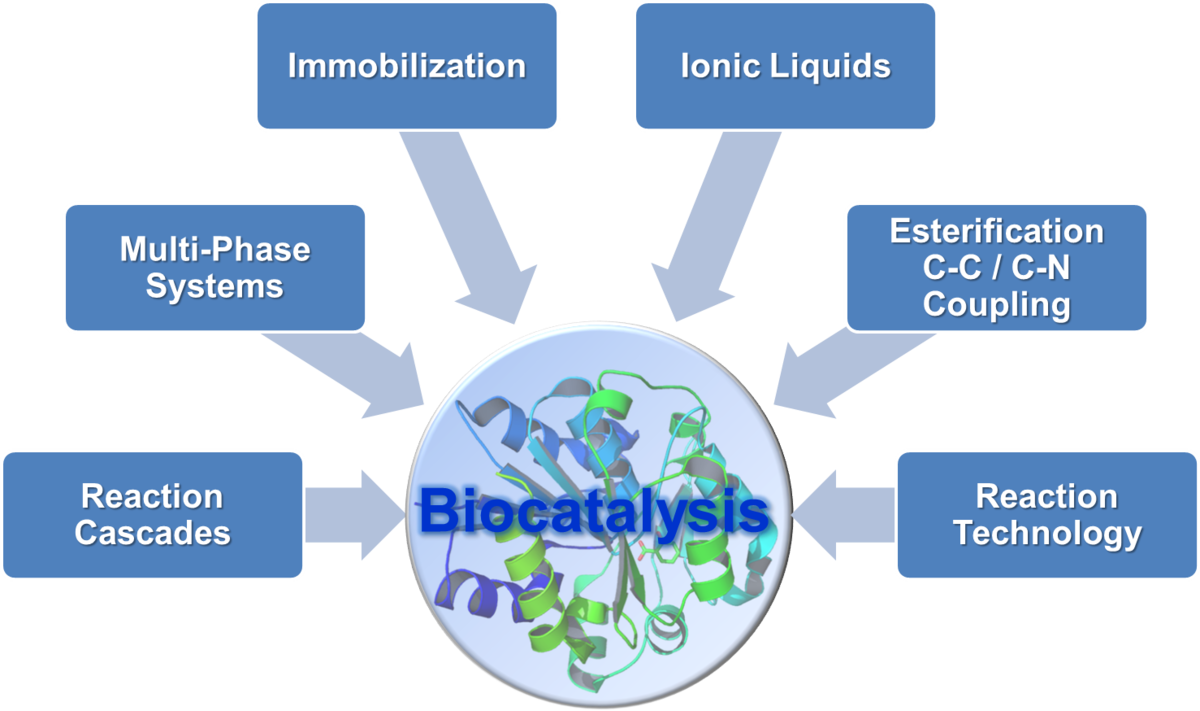- Jost, U., Andreeßen, B., Michalik, D., Steinbüchel, A. and Kragl, U., Downstream processing of serinol from a glycerol-based fermentation broth and transfer to other amine containing molecules. Eng. Life Sci. 2016, doi:10.1002/elsc.201600116
- Engelmann, C.; Illner, S.; Kragl, U., Laccase initiated C C couplings: Various techniques for reaction monitoring. Process Biochem. 2015, 50 (10), 1591-1599.
- Kohse, S.; Neubauer, A.; Pazidis, A.; Lochbrunner, S.; Kragl, U., Photoswitching of enzyme activity by laser-induced pH-jump. J. Am. Chem. Soc. 2013, 135 (25), 9407-9411.
- Wenda, S.; Illner, S.; Mell, A.; Kragl, U., Industrial biotechnology—the future of green chemistry? Green Chem. 2011, 13 (11), 3007-3047.
Biocatalysis has always been the focus of our research. The research extends from sustainable enzymatic synthesis through reaction engineering aspects to new application fields and a subsequent evaluation of the process. Here, novel combinations such as e.g. with two-phase systems, with unconventional solvents such ionic liquids or reaction cascades were investigated (Angew. Chem. Int. Ed., 43: 4529–4531).
For both whole cells and isolated enzymes, innovative steps such as spray congealing and microreactors which can simply transferred to a larger scale are developed (ChemCatChem, 6: 1748–1754). The limiting factors are to be identified by analyzing the therodynamic and kinetic properties of the reaction system. The focus is always on the optimization of the reaction conditions in order to develop an improved process (Chem. Biochem. Eng. Q. 17.1 (2003): 7-18). The eco-efficiency analysis is to be used as a tool for the process development of biocatalytic processes in order to improve the volumetric productivity and to evaluate its potential for industrial application (J. Mol. Catal. B.: Enzym: 2014, 102, 106-114).
Laccase-catalyzed oxidations and lipase-catalyzed esterifications are currently under investigation. In situ measurement techniques are integrated in complex laccase-initiated C-C and C-N coupling reactions to gain insights into the radical reaction sequences. Furthermore, these enzymes are used to synthesize novel compounds, e.g. functionalized mono- and diesters by using lipase-catalyzed reactions.
Mass transport limitations and loss of activity can be reduced and the stability of the biocatalysts can be increased by the immobilization of theses enzymes via microencapsulation.
Further research fields are currently supervised by the junior group leader Jan von Langermann.

